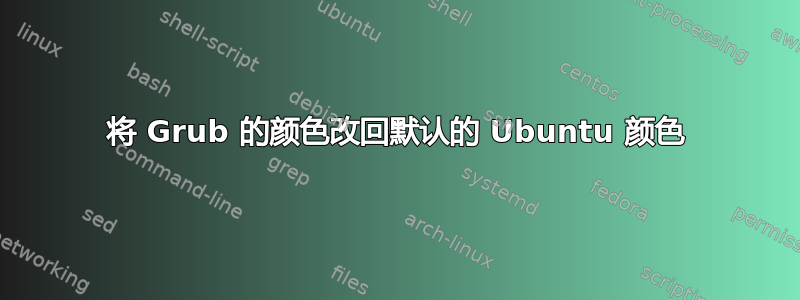
我安装了 kubuntu-desktop,它改变了启动项。我用 修复了启动画面update-alternatives --config all。现在,我该如何修复 grub 的背景颜色?
答案1
看一眼Grub2 - Ubuntu 社区文档。/etc/grub.d/05_debian_theme负责 Grub 的主题设置。颜色和背景图像(如果有)可在此处设置。
这是我的副本,/etc/grub.d/05_debian_theme如果你需要的话,以防万一 -
#!/bin/sh
set -e
# grub-mkconfig helper script.
# Copyright (C) 2010 Alexander Kurtz <[email protected]>
#
# GRUB is free software: you can redistribute it and/or modify
# it under the terms of the GNU General Public License as published by
# the Free Software Foundation, either version 3 of the License, or
# (at your option) any later version.
#
# GRUB is distributed in the hope that it will be useful,
# but WITHOUT ANY WARRANTY; without even the implied warranty of
# MERCHANTABILITY or FITNESS FOR A PARTICULAR PURPOSE. See the
# GNU General Public License for more details.
#
# You should have received a copy of the GNU General Public License
# along with GRUB. If not, see <http://www.gnu.org/licenses/>.
# Include the GRUB helper library for grub-mkconfig.
. /usr/lib/grub/grub-mkconfig_lib
# We want to work in /boot/grub/ only.
test -d "${GRUB_PREFIX}"; cd "${GRUB_PREFIX}"
# Set the location of a possibly necessary cache file for the background image.
# NOTE: This MUST BE A DOTFILE to avoid confusing it with user-defined images.
BACKGROUND_CACHE=".background_cache"
set_default_theme(){
# Set a monochromatic theme for Ubuntu.
echo "${1}set menu_color_normal=white/black"
echo "${1}set menu_color_highlight=black/light-gray"
if [ -e /lib/plymouth/themes/default.grub ]; then
sed "s/^/${1}/" /lib/plymouth/themes/default.grub
fi
}
set_background_image(){
# Step #1: Search all available output modes ...
local output
for output in ${GRUB_TERMINAL_OUTPUT}; do
if [ "x$output" = "xgfxterm" ]; then
break
fi
done
# ... and check if we are able to display a background image at all.
if ! [ "x${output}" = "xgfxterm" ]; then
return 1
fi
# Step #2: Check if the specified background image exists.
if ! [ -f "${1}" ]; then
return 2
fi
# Step #3: Search the correct GRUB module for our background image.
local reader
case "${1}" in
*.jpg|*.JPG|*.jpeg|*.JPEG) reader="jpeg";;
*.png|*.PNG) reader="png";;
*.tga|*.TGA) reader="tga";;
*) return 3;; # Unknown image type.
esac
# Step #4: Check if the necessary GRUB module is available.
if ! [ -f "${reader}.mod" ]; then
return 4
fi
# Step #5: Check if GRUB can read the background image directly.
# If so, we can remove the cache file (if any). Otherwise the backgound
# image needs to be cached under /boot/grub/.
if is_path_readable_by_grub "${1}"; then
rm --force "${BACKGROUND_CACHE}.jpeg" \
"${BACKGROUND_CACHE}.png" "${BACKGROUND_CACHE}.tga"
elif cp "${1}" "${BACKGROUND_CACHE}.${reader}"; then
set -- "${BACKGROUND_CACHE}.${reader}" "${2}" "${3}"
else
return 5
fi
# Step #6: Prepare GRUB to read the background image.
if ! prepare_grub_to_access_device "`${grub_probe} --target=device "${1}"`"; then
return 6
fi
# Step #7: Everything went fine, print out a message to stderr ...
echo "Found background image: ${1}" >&2
# ... and write our configuration snippet to stdout. Use the colors
# desktop-base specified. If we're using a user-defined background, use
# the default colors since we've got no idea how the image looks like.
# If loading the background image fails, use the default theme.
echo "insmod ${reader}"
echo "if background_image `make_system_path_relative_to_its_root "${1}"`; then"
if [ -n "${2}" ]; then
echo " set color_normal=${2}"
fi
if [ -n "${3}" ]; then
echo " set color_highlight=${3}"
fi
if [ -z "${2}" ] && [ -z "${3}" ]; then
echo " true"
fi
echo "else"
set_default_theme " "
echo "fi"
}
# Earlier versions of grub-pc copied the default background image to /boot/grub
# during postinst. Remove those obsolete images if they haven't been touched by
# the user. They are still available under /usr/share/images/desktop-base/ if
# desktop-base is installed.
while read checksum background; do
if [ -f "${background}" ] && [ "x`sha1sum "${background}"`" = "x${checksum} ${background}" ]; then
echo "Removing old background image: ${background}" >&2
rm "${background}"
fi
done <<EOF
648ee65dd0c157a69b019a5372cbcfea4fc754a5 debian-blueish-wallpaper-640x480.png
0431e97a6c661084c59676c4baeeb8c2f602edb8 debian-blueish-wallpaper-640x480.png
968ecf6696c5638cfe80e8e70aba239526270864 debian-blueish-wallpaper-640x480.tga
11143e8c92a073401de0b0fd42d0c052af4ccd9b moreblue-orbit-grub.png
d00d5e505ab63f2d53fa880bfac447e2d3bb197c moreblue-orbit-grub.png
f5b12c1009ec0a3b029185f6b66cd0d7e5611019 moreblue-orbit-grub.png
EOF
# Include the configuration of desktop-base if available.
if [ -f "/usr/share/desktop-base/grub_background.sh" ]; then
. "/usr/share/desktop-base/grub_background.sh"
fi
# First check whether the user has specified a background image explicitly.
# If so, try to use it. Don't try the other possibilities in that case
# (#608263).
if [ -n "${GRUB_BACKGROUND+x}" ]; then
set_background_image "${GRUB_BACKGROUND}" || set_default_theme
exit 0
fi
# Next search for pictures the user put into /boot/grub/ and use the first one.
for background in *.jpg *.JPG *.jpeg *.JPEG *.png *.PNG *.tga *.TGA; do
if set_background_image "${background}"; then
exit 0
fi
done
# Next try to use the background image and colors specified by desktop-base.
if set_background_image "${WALLPAPER}" "${COLOR_NORMAL}" "${COLOR_HIGHLIGHT}"; then
exit 0
fi
# If we haven't found a background image yet, use the default from desktop-base.
if set_background_image "/usr/share/images/desktop-base/desktop-grub.png"; then
exit 0
fi
# Finally, if all of the above fails, use the default theme.
set_default_theme


